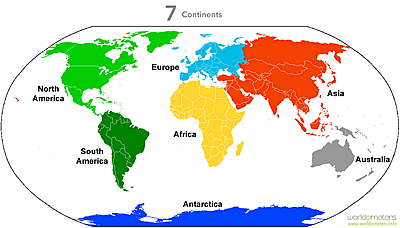Continents
Continent Definition
“Continent” derives from the Latin terra continēns [terra = “land”, continēns = present participle of the verb contineō = con (“together”) + teneō (“I hold”). The meaning is therefore “land held together” or “connected land.”
Originally the term “continent” was applied to any area of land, of any size, not separated by water, including islands.
Concurrently, ever since the times of ancient Greek mariners and philosophers, the world was separated into “parts.” These parts were initially Europe and Asia, with the subsequent addition of Africa and, in 1507, of the Americas. Only in the late nineteenth century such parts of the earth came to be explicitly defined as continents.
Today, continents are understood to be large, continuous, distinct masses of land, ideally (but not necessarily) separated by expanses of water. No required minimum size to qualify as “large” (or “very large”) has been defined, nor the requisite degree of physical separation. Continents are therefore defined by convention rather than a strict criteria. The criteria used can be of geographical, historical, cultural, anthropological, political, or even of philosophical nature.
How many continents are there?
It depends. The loose definition of continent results in numerous ways of separating the world into continents, with models ranging anywhere from 4 to 7 continents.
7 Continents
This is the most widely adopted model and it classifies the following seven continents:
- Africa
- Europe
- Asia
- North America
- South America
- Australia (or Oceania)
- Antarctica
Learn more about the 7 continents.
6 Continents
There are two variations of the six-continent model:
- the first six-continent model (used mostly in France, Italy, Portugal, Spain, Romania, Greece, and Latin America) groups together North America**+**South America into the single continent “America” (or “Americas”).
- the other six-continent model (mostly used in Russia, Eastern Europe, and Japan) combines together Europe + Asia into the single continent “Eurasia”
5 Continents
This model adopts the criteria of both the six-continent models, resulting in the following 5 continents: Africa, Eurasia, America, Oceania (or Australia), and Antarctica.
An alternative five-continent model is the one adopted, among others, by the Olympic Charter, which excludes Antarctica as uninhabited and lists the following five: Africa, Europe, Asia, America, and Oceania (or Australia).
4 Continents
This would probably be the correct subdivision if we adopted a strict definition of continents, ideally defined as large landmasses separated by water. Furthermore, we should consider “separated” only what is naturally separated, excluding therefore the separations resulting from the artificially made Panama Canal (which separates North and South America) and Suez Canal (which separates Africa from Eurasia).
Under this model, the four continents of the world are: Afro-Eurasia (or Eurafrasia), America, and Australia (not Oceania, which combines Australia with smaller countries in the Pacific Ocean which are separated by water), and Antarctica.
An alternative four-continent model, introduced at the beginning of the 20th centry, included Europe, Asia, Africa, and America.
Past Continent Models
Prior to the end of the 18th and 19th century, two continents were sometimes recognized: the Old (Europe, Asia, and Africa together) and the New (North and South America).
Regions instead of Continents
The United Nations Statistics Division (which we follow when reporting population statistics on this website) groups countries into macro geographical (continental) regions and geographical sub-regions rather than into continents. This system is referred to as the United Nations Geoscheme.
This classification identifies 6 regions: Asia, Africa, Europe (includes Russia), Latin America and the Caribbean (which includes South America, Central America, and the Caribbean), Northern America, and Oceania.
